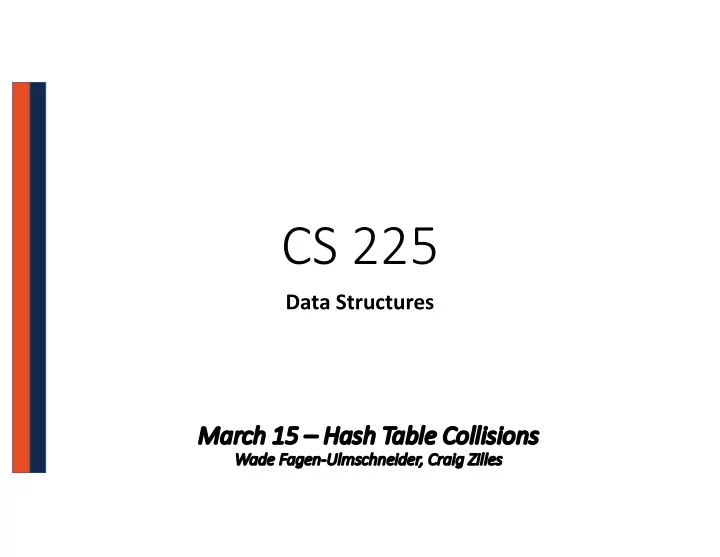

CS 225 Data Structures Mar March h 15 15 – Hash T Table C e Collisions Wade Fa Wa Fagen-Ul Ulmsch schnei eider er, , Cra Craig Zi Zilles
(Example of open hashing) Collision Handling: Sep eparate e Chaining S = { 16, 8, 4, 13, 29, 11, 22 } |S| = n h(k) = k % 7 |Array| = N 0 1 2 3 4 5 6 Worst Case SUHA Insert Remove/Find
(Example of closed hashing) Col Collision on Handling: Prob obe-based ed Hashing S = { 16, 8, 4, 13, 29, 11, 22 } |S| = n h(k) = k % 7 |Array| = N 0 1 2 3 4 5 6
(Example of closed hashing) Col Collision on Handling: Linea ear Probing S = { 16, 8, 4, 13, 29, 11, 22 } |S| = n h(k) = k % 7 |Array| = N Try h(k) = (k + 0) % 7, if full… 0 Try h(k) = (k + 1) % 7, if full… 1 Try h(k) = (k + 2) % 7, if full… 2 Try … 3 4 5 6 Worst Case SUHA Insert Remove/Find
A Problem em w/ Linea ear Probing Primary clustering: Description: Remedy:
(Example of closed hashing) Collision Handling: Double e hashing S = { 16, 8, 4, 13, 29, 11, 22 } |S| = n h(k) = k % 7 |Array| = N Try h(k) = (k + 0*h 2 (k)) % 7, if full… 0 Try h(k) = (k + 1*h 2 (k)) % 7, if full… 1 Try h(k) = (k + 2*h 2 (k)) % 7, if full… 2 Try … 3 4 h(k, i) = (h 1 (k) + i*h 2 (k)) % 7 5 6
Running Times es The expected number of probes for find(key) under SUHA Linear Probing: (Don’t memorize these • Successful: ½(1 + 1/(1-α)) equations, no need.) • Unsuccessful: ½(1 + 1/(1-α)) 2 Instead, observe: Double Hashing: • Successful: 1/α * ln(1/(1-α)) - As α increases: • Unsuccessful: 1/(1-α) Separate Chaining: - If α is constant: • Successful: 1 + α/2 • Unsuccessful: 1 + α
Running Times es The expected number of probes for find(key) under SUHA Linear Probing: • Successful: ½(1 + 1/(1-α)) • Unsuccessful: ½(1 + 1/(1-α)) 2 Double Hashing: • Successful: 1/α * ln(1/(1-α)) • Unsuccessful: 1/(1-α)
ReH eHashing What if the array fills?
Which collision resolution strategy is better? • Big Records: • Structure Speed: What structure do hash tables replace? What constraint exists on hashing that doesn’t exist with BSTs? Why talk about BSTs at all?
Recommend
More recommend